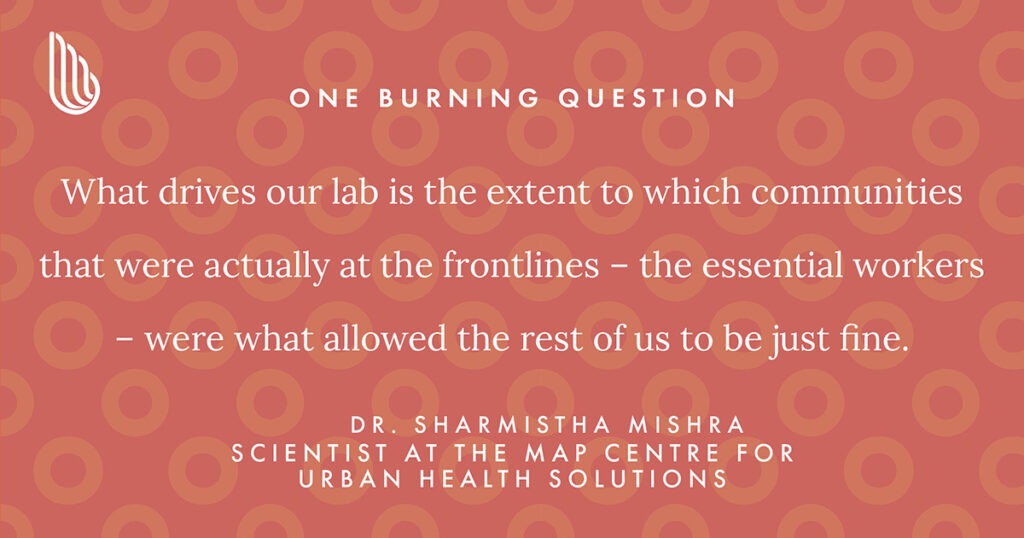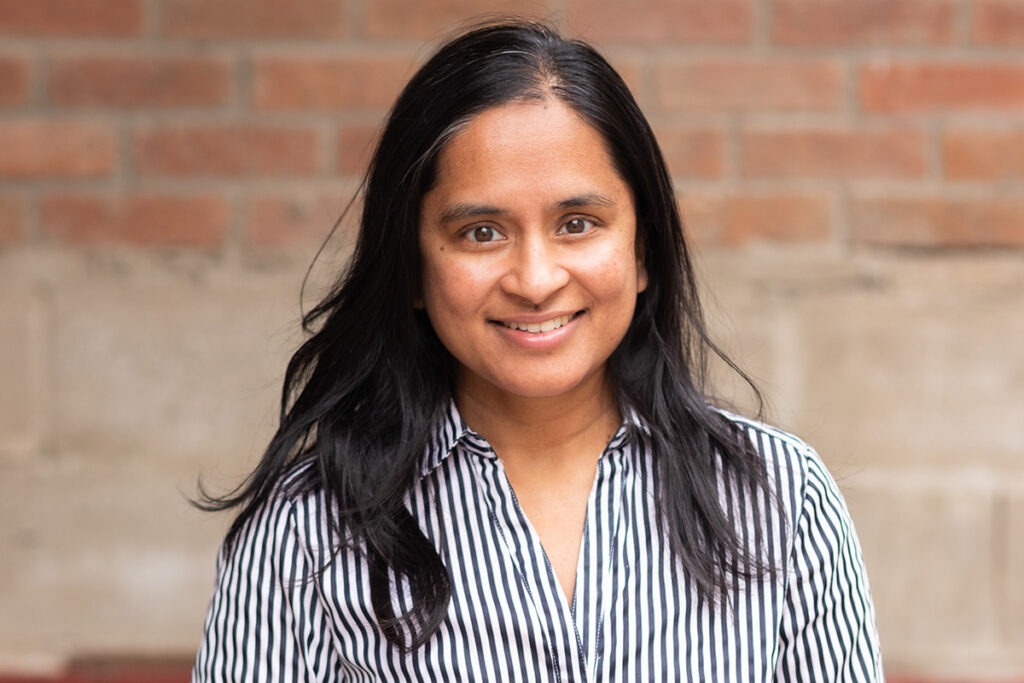Dr. Sharmistha Mishra’s #OneBurningQuestion: What drives pandemics and why?

Dr. Sharmistha Mishra’s research has shown deep inequities in the spread of COVID-19 and the response to the virus. For her, it’s personal.
“You can see your uncles and aunties in the patients you look after, in the data that you’re working with,” she says. “With most of my family living in India and also affected, the underlying social and structural context of transmission was hard to miss.”

Dr. Mishra, a scientist at the MAP Centre for Urban Health Solutions and an Infectious Diseases physician at St. Michael’s, works with her team to get at the “why” of the COVID-19 pandemic. Why is transmission more prominent in some neighbourhoods and networks? Why do some forms of essential work correlate with higher rates of COVID-19? Why have the impacts of the pandemic and the benefits of public health measures been inequitably distributed?
In three recent studies, one about COVID-19 cases and deaths among essential workers in Toronto; one about how variants of concern concentrated where previous variants had similarly clustered; and a third about increased cases of COVID-19 by socioeconomic factors and geography, Dr. Mishra and her colleagues tackle the role of social determinants of health in the pandemic and its response head-on.
To that end, the team has also developed methods to help generate more nuanced mathematical models. These models aim to capture the sources of similarity and of differences between transmission contexts and the extent to which a failure to address underlying context undermines the anticipated impact of a public health response.
“A big part of trying to get at the underlying context in which these infections are occurring is frustration and disappointment in seeing people talk about communities, the lived realities and context of work and households in a way in which is shaming and stigmatizing,” Dr. Mishra says.
“What’s fundamental to any epidemic or pandemic is that things are interconnected. Previous epidemics have shown us that a one-size-fits-all approach to public health strategies can amplify inequities, and that prioritized and tailored strategies that specifically address the underlying, or mechanistic, context of risk are the most effective and efficient in reducing transmission and its health consequences.”
The Discovery
There have been just over 181,000 cases of COVID-19 in Toronto, with known and documented increased risks related to economic and long-standing structural factors including housing and systemic racism.
Dr. Mishra and her team revealed three key contexts that increase risk: occupation, household density, and how these two intersect. They discovered that neighbourhoods with the highest proportion of essential workers were more likely to experience higher transmission and less likely to benefit from shelter-in-place mandates.
They also found that there has been a consistent pattern, established early, of rapid concentration of COVID-19 in small geographic areas. COVID-19 has burdened areas of Toronto where residents have lower incomes, dwellings characterized by household crowding, and occupations that are not amenable to remote work. This pattern has been similar across cities in Canada: according to another recent preprinted study by Dr. Mishra’s team, 50 per cent of cases occurred in 25 per cent of the population, with many high-income neighbourhoods with zero cases.
“In the early part of the pandemic the cases were concentrated in high-income neighbourhoods largely related to travel,” Dr. Mishra said. “Then the disease crossed over and went right into neighbourhoods where there are lower incomes, greater diversity, and more essential workers. Transmission then concentrated in lower-income neighbourhoods throughout the pandemic.”
The Impact
“As infectious diseases epidemiologists, as people who work on epidemics and outbreaks, the first thing we’re taught is to dive deep and understand the why of the differences in transmission,” Dr. Mishra said.
Understanding the context of transmission and why it concentrates in certain places and populations and networks will ensure interventions meaningfully address the social and structural factors that facilitate both acquisition and onward transmission risks. Resourcing, prioritizing, and tailoring interventions to reduce COVID-19 in the communities hit hardest benefits everyone. Fundamental epidemic theory and decades of epidemiological and modeling research across many infectious diseases have shown that added protection to those living and working in conditions that place them most at risk of onward transmission is the most effective and efficient approach to halting epidemics.
“Part of what drives our lab is the extent to which the most affected communities and subsets of the population that were actually at the frontlines – the essential workers – were what allowed the rest of us to be just fine.”
Dr. Mishra and her team continue to study other factors of transmission, such as the movement of people between Ontario neighbourhoods (preprinted online here) to generate a critical piece of epidemic modeling, uncovering which networks are connected with others and how this is characterized by the social determinants of health. They’re also examining the impact of specific strategies and interventions that were put in place, the extent to which they slowed transmission, and for whom.
“We are working on systematically answering questions with data-driven modeling on quantifying the impact of interventions as they were implemented by asking who was reached, who benefited, in what context, and to what extent did our public health response reduce or amplify inequalities,” Dr. Mishra said.
“We’re trying to get at a pandemic response moving forward that is really about what drives differences in transmission. Over this next year to two years there’s going to be a deep, rigorous, concerted and probably quite concerning and challenging look at what we did and did not do, what worked, what didn’t, and why. And we will need to reflect: who was and was not at the tables informing, designing, communicating, and implementing strategies in response to COVID-19?”
More #OneBurningQuestion articles
- Dr. Gaspard Montandon: Can we create pain killers that don’t kill?
- Dr. Joanna Sale: Can we stop devastating hip fractures?
- Dr. Charles de Mestral: How do we stop the most devastating outcome of diabetes and poor circulation?
- Dr. Cilia Mejia-Lancheros: How does mental-health related stigma affect homeless people?
- Dr. Yeni Yucel: Can the eye unlock secrets to ALS?
- Dr. Michael Cusimano: How do we stop injury?
By: Ana Gajic
